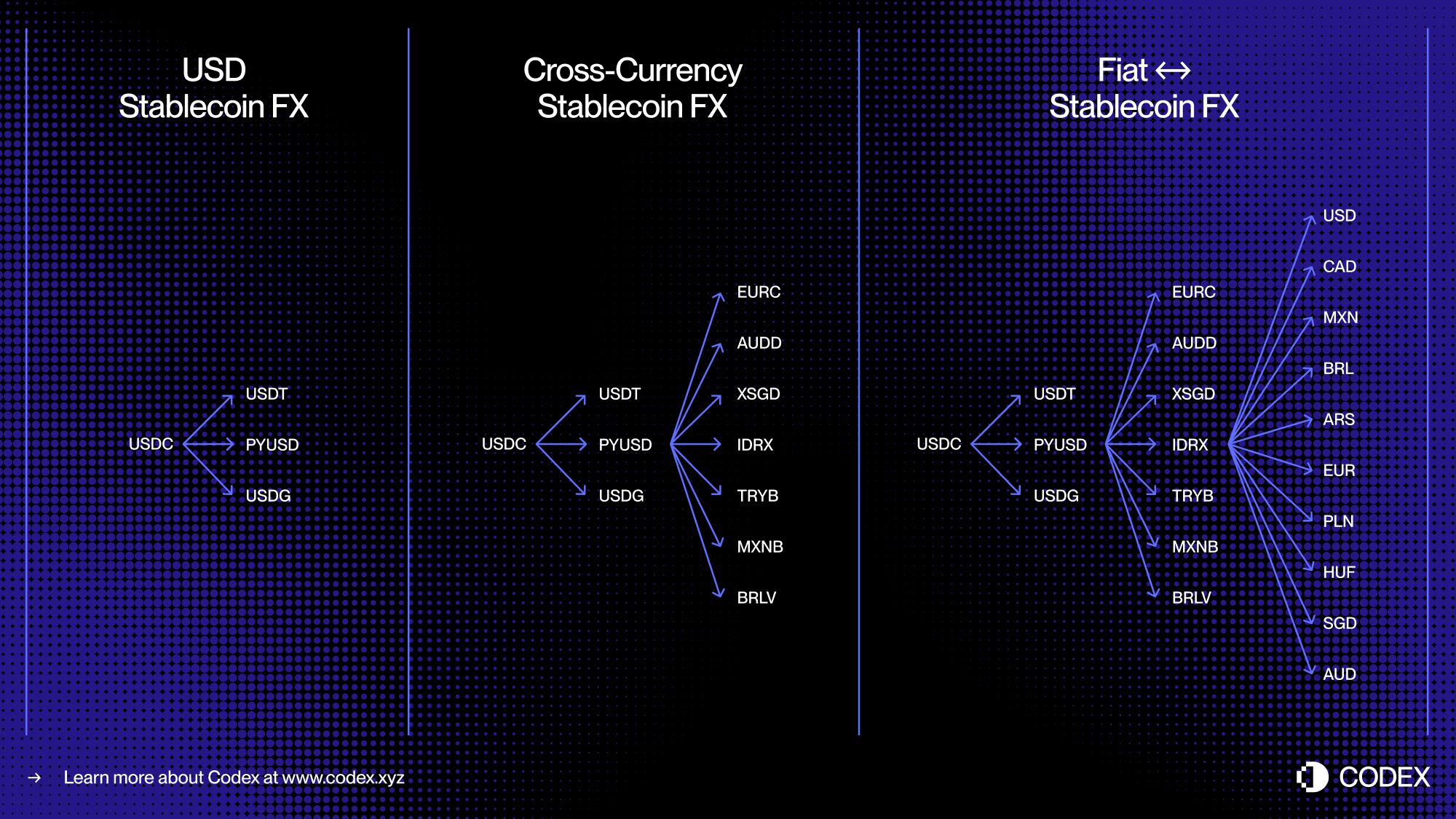The next frontier for stablecoins is in the re-platforming of critical global financial infrastructure. The multi-trillion-dollar FX market represents the most significant opportunity to accelerate this shift.
By solving the inherent complexities of digital currency exchange, onchain FX is poised to be the crucial layer that translates the promise of stablecoins into real-world utility and mass adoption.
FX Markets Are a Massive Opportunity
The sheer scale of global FX markets underscores a vast, friction-filled landscape ripe for DeFi disruption.
- Trillion-Dollar Scale: According to the Bank for International Settlements, global FX volumes reached an immense $9.6 trillion per day in 2025. Even a fractional migration of this volume to efficient, transparent onchain rails represents a high-value opportunity.
- The Dollar Dominance: The US dollar is on one side of 89% of all trades, cementing its unrivaled dominance. Every one of the top 10 most traded currency pairs includes the dollar, reaffirming its role as the world’s primary vehicle currency.
- The Unmet Need for Non-USD Stablecoins: For stablecoins to achieve global status, the ecosystem must support more than just the US dollar. While the USD dominates, other major currencies command a substantial share of global FX: the euro (29% share), Japanese yen (17%), and pound sterling (10%).
True mass adoption requires a full suite of fiat-backed stablecoins to represent these currencies, all seamlessly and efficiently interchangeable via onchain FX protocols.
.png)
Onchain FX is Critical for Mass Adoption of Stablecoins
For stablecoins to fulfill their promise as the universal digital payment rail, they must abstract away the current friction of cross-currency conversion. This requires a robust FX layer.
- Solving the Cross-Border Payment Gap: Cross-border payments, global salary payouts, and remittances all eventually require conversion into local stablecoins or fiat currencies. Without an efficient onchain FX mechanism, users are inevitably forced back to legacy financial systems.
- Decoupling FX from Payment Networks: Using a USD-denominated stablecoin card (e.g., a USDC card) outside the U.S. remains expensive, as card networks still levy FX fees for conversion to the local fiat. Onchain FX offers the potential to decouple the underlying asset from the payment network's expensive conversion layer.
- Enabling Universal Settlement: Mainstream commerce and next-generation AI agents operating via protocols like x402 cannot manage pools of every stablecoin. Merchants must be able to accept any stablecoin and have it instantaneously and automatically converted into their preferred domestic stablecoin.
- Streamlining Global Trade Settlement. The legacy trade finance system is slow, paper-heavy, and reliant on intermediaries like banks and Letters of Credit. As supply chain documents and real-world assets move onchain, settlement needs to evolve too. Onchain FX is the missing piece, enabling instant, low-cost currency conversion so goods and payments can settle simultaneously through Delivery-versus-Payment.
Stablecoin FX Brings Additional Complexity
Foreign exchange in the digital asset ecosystem is not a single problem to solve but a multi-dimensional system to redesign. Stablecoin FX introduces new complexities, each representing a distinct frontier for innovation.
- USD Stablecoin FX (e.g., USDT ↔ USDC): This is the most developed segment of the market and demonstrates that onchain FX can already operate at scale. For example, the USDC/USDT pool on Uniswap processed more than $11 billion in transactions over the past 30 days, highlighting the potential for high-liquidity, low-friction digital markets.
- Cross-Currency Stablecoin FX (e.g., USDC ↔ EURC): The next frontier involves facilitating seamless exchange between stablecoins pegged to different fiat currencies. Building deep, resilient liquidity pools for these pairs is critical to replicating, and ultimately improving upon, the efficiency of traditional interbank FX networks.
- Fiat ↔ Stablecoin FX (e.g., USD ↔ USDC): Often referred to as the “on/offramp,” this segment bridges traditional finance and the onchain economy. Its success depends on establishing a compliant, secure, and scalable infrastructure capable of managing the regulatory and operational complexity of fiat-to-digital conversion at a global scale.
Together, these layers form the foundation of a new FX architecture, one that extends beyond currency conversion to enable programmable, 24/7 settlement for the digital economy.

Opportunities for DeFi Businesses
Addressing the three-dimensional FX challenge, across USD-denominated stablecoins, cross-currency stablecoins, and fiat-to-stablecoin conversions, is essential for the mass adoption of stablecoins. Solving it will not only enable frictionless value transfer, but also unlock a new generation of infrastructure-scale business opportunities for onchain and DeFi innovators.
- Build Cross-Stablecoin Liquidity Venues: The most immediate opportunity lies in developing capital-efficient liquidity infrastructure for cross-currency stablecoin FX (e.g., USDC ↔ EURC). This requires reimagining Automated Market Makers and liquidity models capable of handling large-value transfers with minimal slippage across stablecoins pegged to different fiat currencies.
Such platforms would effectively compete with, and eventually complement, traditional OTC FX desks, positioning DeFi as a viable alternative for institutional-grade foreign exchange.
- Refine Institutional On/Offramps: The conversion layer between fiat and stablecoins remains one of the most regulated and operationally intensive areas of the ecosystem. Building compliant, scalable, and high-throughput ramps represents a critical enabler for institutional adoption.
These services will form the trusted financial gateway connecting traditional capital markets with digital assets, facilitating the secure movement of liquidity both into and out of the onchain economy.
- Develop a Payment Abstraction Layer: At the application layer, innovators can simplify global payments by abstracting away FX complexity from the end user. This can take the form of middleware that automatically executes onchain FX conversions at the point of payment, reducing friction and expanding global reach.
By embedding onchain FX directly into payment logic, businesses can offer instant, currency-agnostic settlement, a key differentiator in the next wave of digital commerce.
Where Do We Go from Here?
The trillion-dollar FX market won’t move onchain overnight, but the transition has already begun. As stablecoins mature from a dollar-centric experiment into a global payments network, efficient, programmable FX becomes the next logical step.
To unlock this future, the world needs more than liquidity; it needs purpose-built infrastructure. Codex is designed to meet that challenge:
- Codex Chain is a settlement layer purpose-built for stablecoins, delivering predictable transaction costs, native FX capabilities, and embedded compliance. It provides the foundation for building a truly global, programmable, and compliant onchain FX platform.
- Complementing this core technology, Codex Avenue is a global liquidity and FX hub that connects onchain and real economies. It simplifies local on/offramp, as well as stablecoin swaps, enabling frictionless movement between stablecoins and fiat across markets and currencies.
- We further collaborate with a strong network of partners offering expert support in stablecoin issuance, custody, and the compliance needed for this new open standard.
The stable door is open. The question is: what will you build on the other side? Let’s chat: info@codex.xyz.

